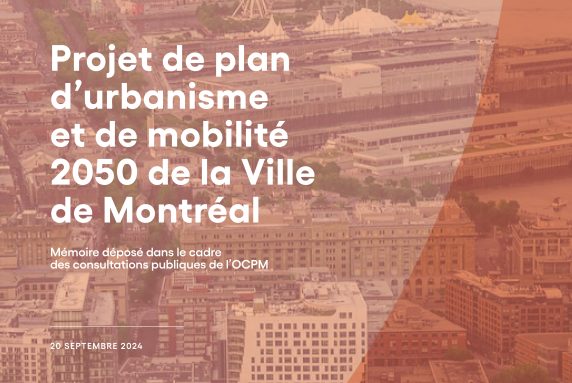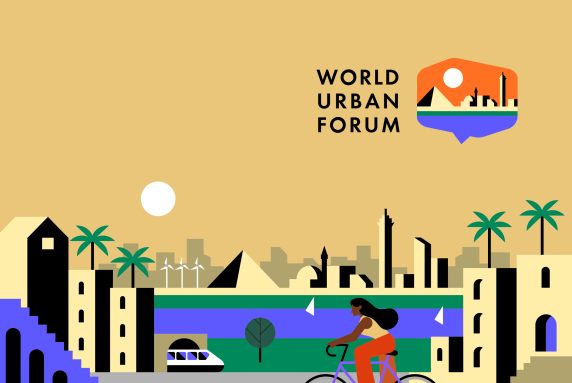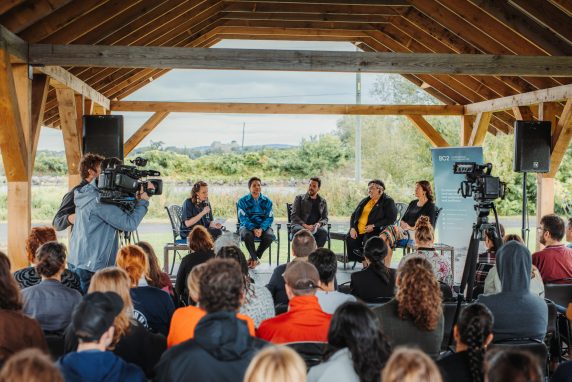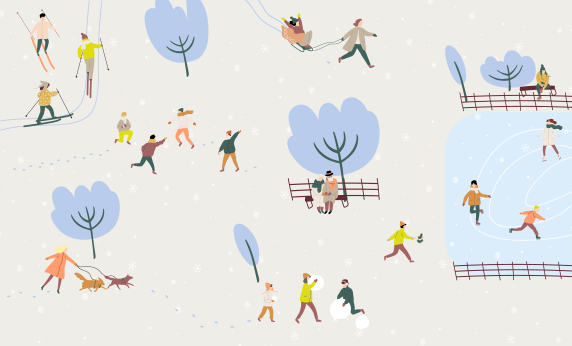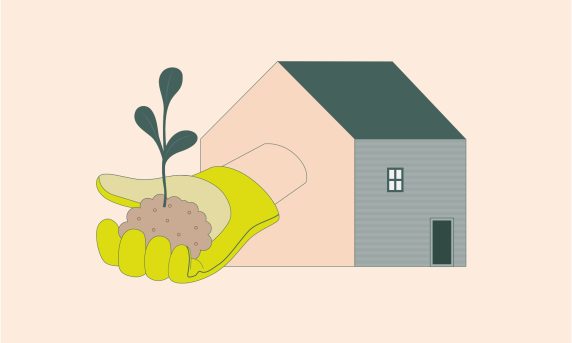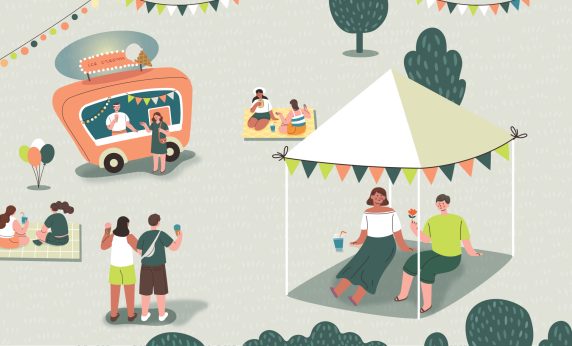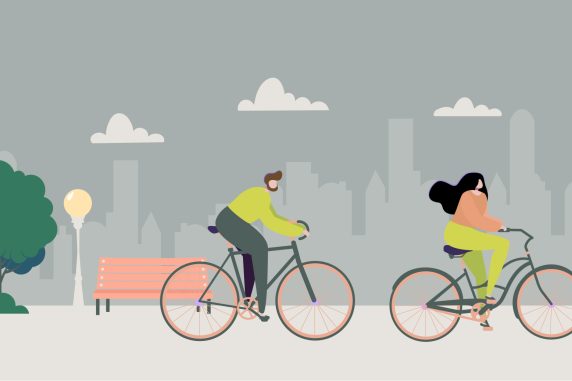Land use planning is transforming our living environments. Our experts dissect the issues raised by current events and share the news and ideas that make us progress together.
Réflexions BC2
Nordic urbanism as a field of territorial resilience
Chapters
A. Urban planning and nordicity
While encompassing three seasons that vary from mild to hot, the essence of northern places is most significantly marked by winter. Nordicity, the set of characteristics specific to places intimately linked to the cold, snow, and the short days of winter, significantly influences the daily rhythms and overall lifestyles of those living in northern regions.
The term ‘nordicity’ was coined in the early 1960s by Quebec geographer and linguist Louis-Edmond Hamelin to refer to the socio-spatial conditions of high-altitude regions. Nordicity permeates Quebec’s culture and identity from top to bottom, manifesting itself as much in literary works as in our techniques for constructing jackets, meals, and buildings.
This concept of nordicity offers a broad perspective on how human societies adapt to the extreme conditions of the North, encapsulating our dynamic relationship with a territory that transforms through the seasons. Nordicity thus conveys the idea that the functional value of space varies with the changing seasons, which affects social, cultural, and economic conditions.
B. Winter’s dynamics of inequality
As the cold sets in, everyday activities move indoors. Winter shrinks our living spaces as courtyards, balconies and green roofs disappear under the weight of snow. These circumstances are more striking for those who live most of their social life in the public domain, as well as for families that can only entertain their loved ones in their backyards or gardens.
In this process, winter intensifies social inequalities, particularly for the most vulnerable. Staying warm is expensive. Large, heated indoor spaces are more accessible for some than others. Homeless people face new risk factors when temperatures drop; elderly people, and anyone with disabilities, are disproportionately affected by extreme weather as pedestrians are forced to carve out new paths to avoid ice patches, snowbanks and blocked sidewalks.

The homeless population, both in big cities and smaller towns, is particularly impacted by the harsh conditions of the North. Notably, homelessness is not just an issue in large urban areas, but also in medium-sized and smaller communities:
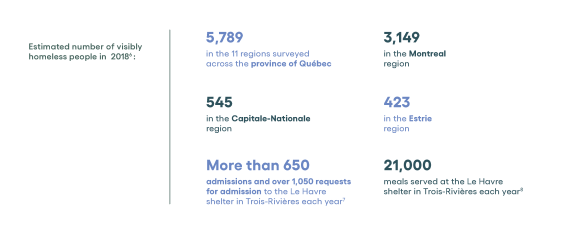
C. Winter costs
For municipalities, winter generates expenses. For example, this year in Quebec City, snow removal operations account for about 4.4% of the $1,772.2 million allocated to the annual municipal budget. This amount is comparable to that allocated to the fire protection service, and seven times higher than the budget for urban planning and environmental management.9 In Montreal, snow removal represents 2.9% of the municipal budget, or nearly $187 million.
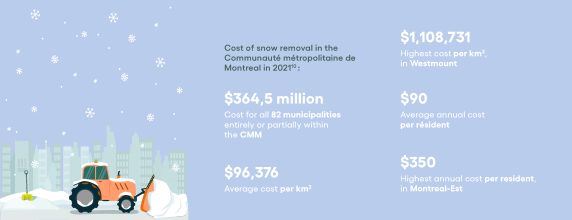
Winter conditions can drive revenues in the tourism industry. In 2021, this industry in Quebec alone included nearly 24,000 businesses, and despite the challenges faced during the Covid-19 health crisis, it is expected that Canada’s tourism sector will rebound to its pre-pandemic levels by 2024.11 Canada is preparing to host over 5 million international travelers this winter,12 in additional to hundreds of thousands of domestic tourists. A 2019 study revealed that prior to the pandemic, around 11% of Quebecers had planned winter trips within the province.13 Of these, around 41% were looking forward to leisure activities, 29% aimed for outdoor adventures, and 9% planned city vacations.
Canada is recognized globally as a winter tourist destination, thanks to activities like skiing, snowboarding, and snowmobiling. The ski resorts in the Laurentians, Eastern Townships, and Charlevoix regions alone draw close to a million visitors annually from the United States and Ontario, while Banff and Whistler draw in many more on the other coast. The country’s northern climate plays a crucial role in bolstering the winter tourism industry, which brings substantial economic benefits to many villages and regions further removed from large urban centers.
D. Major Northern Spatial Planning Practices
Many cities are creating strategic plans to both embrace winter’s opportunities and lessen the impact of the cold. This is the driving force behind the Winter Cities movement, which aims to adjust urban environments to suit Nordic conditions. The movement encourages innovation in design and the use of public spaces in every season.
The winter plans produced for Edmonton14 and Beaumont15 in Alberta stand out for the comprehensive range of landscaping interventions they propose.16 The plans are structured around four main principles:
– Accessibility: Improve access and mobility with an equity perspective
– Comfort: Flatten the effects of cold weather in strategic areas
– Visual Appeal: Brighten an urban landscape dulled by snow and darkness
– Play: Offer outdoor sports activities
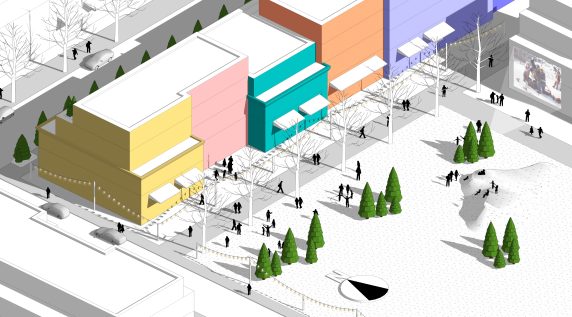
Several strategies in these Winter Cities plans aim to soften winter’s harsh aspects, like the cold and darkness, and introduce color to snow-laden landscapes. These strategies include creating warm spaces in public areas to enhance outdoor enjoyment. While reducing winter’s severity through microclimates or fire pits is beneficial, a complementary approach embraces the unique features of winter, such as the cold and prolonged nights, to create special winter experiences.
The upcoming second publication in this Nordicity series will explore the parameter for such an approach by introducing a framework anchored in the principles of territorial resilience, together with practical examples of spatial strategies conceived with spatial equity, climate change, scalability and the human experience in mind.
References
1 “Chutes Chez Les Aînés Au Canada – Infographie,” Agence de la santé publique du Canada, 2015, https://www.canada.ca/fr/sante-publique/services/promotion-sante/vieillissement-aines/publications/publications-grand-public/chutes-chez-aines-canada-deuxieme-rapport/chutes-chez-aines-canada-infographie.html.
2 Agence de la santé publique du Canada, “Chutes Chez Les Aînés Au Canada : Deuxième Rapport,” Gouvernement, 2014, https://www.canada.ca/fr/sante-publique/services/promotion-sante/vieillissement-aines/publications/publications-grand-public/chutes-chez-aines-canada-deuxieme-rapport.html.
3 Statistique Canada Gouvernement du Canada, “Estimations de La Population Au 1er Juillet, Par Âge et Sexe,” 2022, https://www150.statcan.gc.ca/t1/tbl1/fr/tv.action?pid=1710000501.
4 Institut de la statistique du Québec, “Portrait Des Personnes Aînées Au Québec” (Gouvernement du Québec, 2023), 18.
5 Institut de la statistique du Québec, 18.
6 Eric Latimer and François Bordeleau, “Dénombrement Des Personnes En Situation d’itinérance Au Québec Le 24 Avril 2018” (Montreal: Ministère de la Santé et des services sociaux, 2019).
7 “Centre Le Havre,” n.d., http://centrelehavre.com/.
8 “Centre Le Havre.”
9 Services des Finances, “Budget 2023” (Ville de Québec: Ville de Québec, 2022).
10 Data from the Ministère des Affaires municipales et de l’Habitation, compiled by BC2.
11 Destination Canada, “Perspectives Touristiques: Faits Saillants Des Prévisions” (Ottawa: Destination Canada, 2022).
12 “Recherche: Total des arrivés de voyageurs étrangers,” Destination Canada, n.d., https://www.destinationcanada.com/fr/recherche.
13 “Sondage, Intentions de Voyage. Hiver 2019-2020” (Gouvernement du Québec, n.d.), https://cdn-contenu.quebec.ca/cdn-contenu/tourisme/etudes-statistiques/intentions-voyage-hiver-2019-2020.pdf?1594662017.
14 “Winter Design Guidelines: Transforming Edmonton into a Great Winter City” (Edmonton: City of Edmonton, 2016).
15 Dialog, “Beaumont Winter City Strategy” (Beaumont: City of Beaumont, 2022).
16 See also, Vivre en Ville, “Ville d’hiver: Principes et Stratégies d’aménagement Hivernal Du Réseau Actif d’espaces Publics Montréalais” (Montreal: Vivre en Ville, 2018).
1 “Chutes Chez Les Aînés Au Canada – Infographie,” Agence de la santé publique du Canada, 2015, https://www.canada.ca/fr/sante-publique/services/promotion-sante/vieillissement-aines/publications/publications-grand-public/chutes-chez-aines-canada-deuxieme-rapport/chutes-chez-aines-canada-infographie.html.
2 Agence de la santé publique du Canada, “Chutes Chez Les Aînés Au Canada : Deuxième Rapport,” Gouvernement, 2014, https://www.canada.ca/fr/sante-publique/services/promotion-sante/vieillissement-aines/publications/publications-grand-public/chutes-chez-aines-canada-deuxieme-rapport.html.
3 Statistique Canada Gouvernement du Canada, “Estimations de La Population Au 1er Juillet, Par Âge et Sexe,” 2022, https://www150.statcan.gc.ca/t1/tbl1/fr/tv.action?pid=1710000501.
4 Institut de la statistique du Québec, “Portrait Des Personnes Aînées Au Québec” (Gouvernement du Québec, 2023), 18.
5 Institut de la statistique du Québec, 18.
6 Eric Latimer and François Bordeleau, “Dénombrement Des Personnes En Situation d’itinérance Au Québec Le 24 Avril 2018” (Montreal: Ministère de la Santé et des services sociaux, 2019).
7 “Centre Le Havre,” n.d., http://centrelehavre.com/.
8 “Centre Le Havre.”
9 Services des Finances, “Budget 2023” (Ville de Québec: Ville de Québec, 2022).
10 Data from the Ministère des Affaires municipales et de l’Habitation, compiled by BC2.
11 Destination Canada, “Perspectives Touristiques: Faits Saillants Des Prévisions” (Ottawa: Destination Canada, 2022).
12 “Recherche: Total des arrivés de voyageurs étrangers,” Destination Canada, n.d., https://www.destinationcanada.com/fr/recherche.
13 “Sondage, Intentions de Voyage. Hiver 2019-2020” (Gouvernement du Québec, n.d.), https://cdn-contenu.quebec.ca/cdn-contenu/tourisme/etudes-statistiques/intentions-voyage-hiver-2019-2020.pdf?1594662017.
14 “Winter Design Guidelines: Transforming Edmonton into a Great Winter City” (Edmonton: City of Edmonton, 2016).
15 Dialog, “Beaumont Winter City Strategy” (Beaumont: City of Beaumont, 2022).
16 See also, Vivre en Ville, “Ville d’hiver: Principes et Stratégies d’aménagement Hivernal Du Réseau Actif d’espaces Publics Montréalais” (Montreal: Vivre en Ville, 2018).


